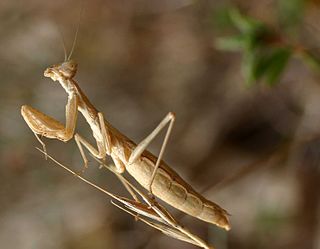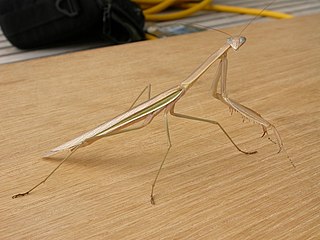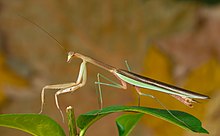
The Carolina mantis is a species of praying mantis of the subfamily Stagmomantinae.

The European mantis is a large hemimetabolic insect in the family of the Mantidae ('mantids'), which is the largest family of the order Mantodea (mantises). Their common name praying mantis is derived from the distinctive posture of the first pair of legs that can be observed in animals in repose. It resembles a praying attitude. Both males and females have elongated bodies with two pairs of wings. The most striking features that all Mantodea share are a very mobile, triangular head with large compound eyes and their first pair of legs, which is highly modified for the efficient capture and restraint of fast-moving or flying prey.

Tenodera is a genus of mantis in the family Mantidae which contains several species of praying mantises. The species in this genus can be found primarily in Africa, Asia and Australia, but also North America.

Miomantis caffra is a species of praying mantis native to southern Africa. It appeared in New Zealand in 1978, and was found more recently in Portugal and Los Angeles, USA, likely spread through the exotic pet trade. Females are facultatively parthenogenetic and unmated females can produce viable offspring.

Hymenopus coronatus is a mantis from the tropical forests of Southeast Asia. It is known by various common names, including walking flower mantis, orchid-blossom mantid and (pink) orchid mantis. It is one of several species known as flower mantis, a reference to their unique physical form and behaviour, which often involves moving with a “swaying” motion, as if being “blown” in the breeze. Several species have evolved to mimic orchid flowers as a hunting and camouflaging strategy, “hiding” themselves in plain view and preying upon pollinating insects that visit the blooms. They are known to grab their prey with blinding speed.

Iris oratoria, known by the common name Mediterranean mantis, due to humans first studying it in lands around the Mediterranean Sea, is a species of praying mantis. Its range is expanding in the Middle East, Western Asia and the United States.

Phyllocrania paradoxa, common name ghost mantis, is a small species of mantis from Africa remarkable for its leaf-like body. It is one of the three species in the genus Phyllocrania. It is known for its distinct and exclusive camouflaged appearance of a dry weathered leaf.

Litaneutria minor, or the agile ground mantis or minor ground mantid, is native to the drier regions of North America. L. minor is found in the United States in Colorado, Arizona to Mexico, and the eastern regions of Washington to California. They also can be found in Canada in the southern Okanagan Valley and are Canada's only native mantis. They are very active hunters and will be seen running across the ground from early spring to late summer.

Pseudovates chlorophaea, with the common name Texas unicorn mantis, is a species of praying mantis in the family Mantidae. It is native to the southern United States, Mexico, Central America, and northern South America.

Tenodera angustipennis is a species of mantis native to Asia and nearby areas of Oceania. The species was introduced and became established in the eastern United States. Tenodera angustipennis was noticed as early as 1921 in Aberdeen, Maryland, but that occurrence was not noted in a published record until 1933.

Sphodromantis viridis is a species of praying mantis that is kept worldwide as a pet. Its common names include African mantis, giant African mantis, and bush mantis.

Ameles decolor is a species of small praying mantis native to the west Mediterranean and North Africa. A. decolor was first described by entomologist Domenico Cyrillo in 1787, and its current classification was established in 1976 by Karl Harz and Alfred Peter Kaltenbach. A. decolor presents as a small, light brown mantis with females tending to appear larger than their male counterparts. The mating patterns of A. decolor are considered some of the most complex amongst praying mantises, with males presenting two different styles of courtship. Their habitat favours shrublands, grasslands, and wooded areas.

Ameles spallanzania, common name European dwarf mantis, is a species of praying mantis.

Idolomantis is a monotypic genus of praying mantises in the family Empusidae. It contains the single species, Idolomantis diabolica, commonly known as the devil's flower mantis or giant devil's flower mantis. It is one of the largest species of praying mantises, and is possibly the largest that mimics flowers.

Pseudoharpax virescens, common name Gambian spotted-eye flower mantis, is a species of praying mantis native to western, central and eastern Africa. It takes its name from two eye spots on the dorsal side of the abdomen of adult females.

Empusa pennata, or the conehead mantis, is a species of praying mantis in genus Empusa native to the Mediterranean Region. It can be found in Portugal, Spain, southern France, Italy and on the mediterranean coasts of Morocco, Algeria, Tunisia, Libya, Turkey and Egypt. Because of its cryptic nature, or also possibly because of its fragmented, low-density populations, it is rarely encountered in the wild.

Orthodera novaezealandiae, known as the New Zealand mantis or the New Zealand praying mantis, is a species of praying mantis which is, as both the scientific name and common names suggest, indigenous and endemic to New Zealand.

Tenodera australasiae, the purple-winged mantis, is species of praying mantis. Found throughout Australia, it is common in the eastern regions. Both males and females are capable of flight. The species has not been shown to be parthenogenetic.

Mantises are an order (Mantodea) of insects that contains over 2,400 species in about 460 genera in 33 families. The largest family is the Mantidae ("mantids"). Mantises are distributed worldwide in temperate and tropical habitats. They have triangular heads with bulging eyes supported on flexible necks. Their elongated bodies may or may not have wings, but all Mantodea have forelegs that are greatly enlarged and adapted for catching and gripping prey; their upright posture, while remaining stationary with forearms folded, has led to the common name praying mantis.

Tenodera aridifolia, the Japanese giant mantis, is a species of mantis in the subfamily Mantinae. The Chinese mantis, T. sinensis, was once considered to be a subspecies of T. aridifolia, but the species can be distinguished by the shape of male genitalia.



























